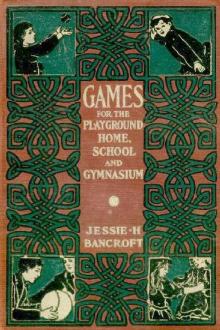Games for the Playground, Home, School and Gymnasium by Jessie Hubbell Bancroft (top novels of all time .txt) 📕

- Author: Jessie Hubbell Bancroft
- Performer: -
Book online «Games for the Playground, Home, School and Gymnasium by Jessie Hubbell Bancroft (top novels of all time .txt) 📕». Author Jessie Hubbell Bancroft
START.—The ball is put in play at the opening of the game, and after each catch by a captain, and after each foul, by being tossed by a neutral person in the center of the ground, the guards on both sides trying to get possession of it. The ball is not considered caught unless it be held in both hands. Any guard so catching it has an opportunity to throw it to his own captain or one of his basemen. The guards on the opposite side of course try to prevent such a catch.
RULES.—It is considered a fair catch for any baseman, including the captain, if the ball be caught on a bound either from the floor, ceiling, or any other object, or from hitting another player.
A ball that goes afield is secured by the guard standing nearest the point where it left the circle. He puts it in play from the point in the circle where it went out.
Other rules are indicated under "Fouls."
FOULS.—It is a foul (1) to kick the ball; (2) to run with the ball; (3) for a guard to step over the dividing line or inside one of the bases; (4) for a baseman to step outside of his own base, even with one foot; (5) to hand the ball instead of tossing; (6) to snatch or bat the ball from an opponent's hands; (7) to hold the ball longer than time enough to turn around quickly, or three seconds.
One point is scored by the opponents whenever a foul is made, and the ball is then put in play again from the center.
SCORE.—One point is scored for a team every time a baseman catches the ball from another baseman of the same team.
Two points are scored for a team every time its captain makes a fair catch, whether the ball has gone around his circle or not, and whether the ball was thrown by one of his basemen or one of his guards on the opposite side of the field. Three points are scored if the ball reaches two different basemen and the captain successively, whether in regular rotation around the circle or not.
Four points are scored if the ball reaches three different basemen and the captain successively, whether in regular rotation around the circle or not. Five points are scored whenever the ball passes entirely around the circle on one side, in regular rotation of basemen, whether the start and finish of that circle be with the captain or some other baseman. Each foul scores one for the opposing team, as described under "Fouls." After the captain catches the ball, no further points may be scored on it in that play and it then goes back to the center to be put again in play.
CAPTAIN BALL—III20 to 40 players.
Playground; gymnasium.
Basket ball; volley ball.
This form of Captain Ball is the most strenuous of any, as freer mass play is encouraged among the guards, and there are fewer restrictions in the form of play, batting and hitting the ball being allowed, which are fouls in other forms of the game. The method of punishing fouls is optional and should be determined before the game begins. The ground is divided somewhat differently than in other forms of the game, by a neutral space between the two fields, where the ball is tossed for sides. The ball scores both for completing a circle and being caught by a captain, but not for catching from one baseman to another, as in II. The captain is stationed in the center instead of in the circumference of the circle, as in I and II.
GROUND.—The ground is divided into two equal parts by a neutral strip about three feet wide through the center. In each half are marked five or more bases in the form of small circles from two to five feet in diameter (or rectangles), outlining part of a large circle or square open toward the center. In the center of each half is marked a small circle or base for the captain. The interest of the game may be enhanced by placing a springboard in the captain's base, on which he should stand.
TEAMS.—The players are divided into two equal teams, consisting each of (1) a captain, (2) a baseman for each base in the outer circle, (3) guards. There should be one less guard on each team than the number of players in its outer circle. For instance, for five basemen, as in the diagram, there should be four guards. The guards belonging to a team are stationed in the opponents' field, and generally begin the game lined up near the neutral territory that runs through the center of the ground. As the game progresses, the guards may scatter in any way that they choose. There are no center runners or fielders in this form of the game, as in some others An umpire is desirable, and a scorer and referee are needed for skillful teams.
OBJECTS OF GAME.—The objects of the game are (1) for the ball to be thrown and caught around the complete circle of basemen; (2) for the outer basemen to throw the ball to their captain in the center; the guards trying (1) to intercept the ball before it can complete a circle; (2) to prevent it being caught by the captain; and (3) to secure possession of the ball and send it to the basemen in their own (the opposite) field.
START.—The ball is put in play in the center of the neutral strip by an umpire or referee. He tosses the ball, and the guards from both sides try to gain possession of it. For this purpose the guards may run anywhere they choose, being permitted on the neutral territory; but as soon as possession of the ball is decided, the guards must return to their respective fields, and may not again leave them until the ball is again put in play. To touch the ball does not give a guard possession of it; he must hold it in both hands. In case of dispute the referee should again toss the ball. When a guard has secured possession of the ball, he and the other guards return to their home fields, and the one having the ball throws it to one of his basemen in the opposite field. The ball is put in play from the center after every point scored, and after it goes afield.
RULES.—The guards are not allowed to step within the bases; they may not cross the boundary lines into the neutral territory, except when the ball is being put in play. Basemen may not step outside of their bases, even with one foot. Should the captain, in catching a ball, step over his base, the catch does not score, but if this be with only one foot, he has the privilege of throwing the ball to one of his basemen without interference from the guards. A throw from a guard in the opposite field to his own captain does not score. Kicking or striking a ball out of a player's hands is allowable. In trying to block a throw, guards may not touch basemen nor step within the bases. Guards will naturally be very watchful of the center, as successful catches by the captain score.
FOULS.—Transgression of any of the previous rules constitutes a foul, penalized by giving the ball to the opposite side or by allowing them to score one point. Which of these two methods is to prevail during a game should be decided before the game starts.
SCORE.—One point is scored for a team every time that the captain catches a ball thrown by one of his basemen. One point is scored for a team whenever the ball is thrown from base to base successively until it completes an uninterrupted circle. Fouls may score or not, as explained under "Fouls." After every point scored, the ball is returned to the umpire and put again in play.
The game is played in two halves of fifteen or twenty minutes each, with a rest of five or ten minutes between the halves. Teams change sides at the beginning of the second half, but they do not change players; that is, guards do not become basemen, and vice versa, as in some other forms of this game.
EMPEROR BALL30 to 40 players.
Playground; gymnasium.
Basket ball.
This game is really a form of Captain Ball, but differs from any of the previous forms in the following points:—
A neutral officer, called the Emperor, is stationed in the center of the field between the two teams, and the ball scores its highest when it has been thrown entirely around one of the circles, from there to the captain in the centre, and from him to the Emperor. There are two fielders, or players at large, who try to intercept the ball before it reaches the Emperor, or to block it in any other part of the play.
GROUND.—In the center of the ground is placed a springboard, box, stool, or other platform for the impartial ruler of the game called the Emperor. The ground on each side of this point is marked out as follows: A series of bases or small circles (the number to vary with the number of players) is drawn so as to form together a large circle with from four to ten feet between each two small ones. The small circles should be from two to five feet in diameter. In the center of this large ring another small circle or base is marked for the captain of the team.
TEAMS.—The players appoint one impartial officer who is the Emperor and stands in the center on a raised base (box, jumping board, or other improvised platform). The balance of the players are divided into two equal teams, consisting each of a captain, two center players, or fielders, and a number of basemen and base guards. The two fielders may go anywhere on the field, but their main duty is to prevent the ball reaching the Emperor from an opponent. They also pick up the ball when it goes afield and hand it to the Emperor for starting again.
Each captain takes his place in a center base; the basemen stand each in a base in the circle surrounding his captain; the guards, of equal number with the basemen, take their places in the opposite field, each being assigned to guard one of the basemen, including the captain of the opposing team, and may not go from the immediate vicinity of the circle he guards.
OBJECTS OF THE GAME.—The objects of the game for each team consist (1) in throwing the ball from baseman to baseman completely around its circle; (2) around the circle as in (1) and in addition, to throw from the last baseman to the center player or captain; and (3) having completed the previous two points, to throw from the captain to the Emperor, who stands between the two halves of the field. The object of the guards, of course, is (1) to intercept the ball so as to prevent the completion of this play in any of its points; and (2) to gain possession of the ball so as to throw it across the field to their own basemen on the opposite side.
START.—The ball is put in play at the beginning of the game, and





Comments (0)